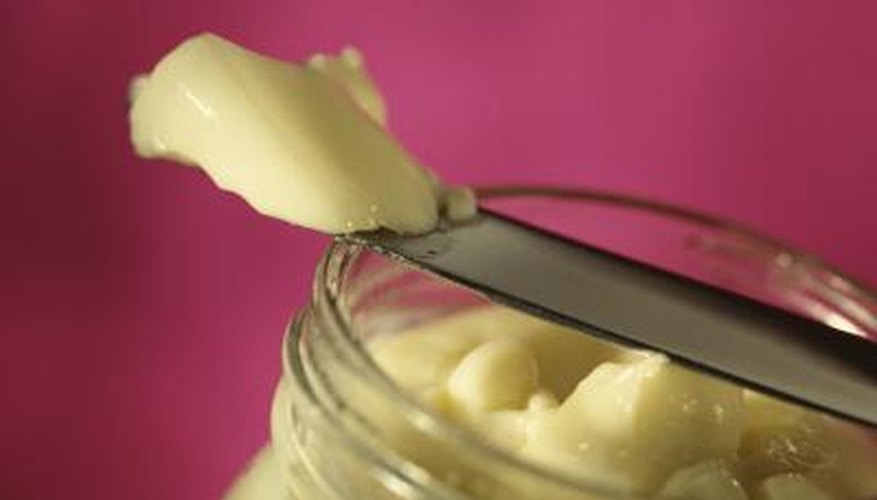With salmonella constantly making the headlines, you may be concerned about whether or not your mayonnaise has gone bad. Although it is true that mayonnaise contains raw eggs, it is only prone to spoilage under certain conditions and will last quite a long time even without refrigeration. Still, exercise caution by checking carefully if you feel your product has spoiled.
The Risks
Mayonnaise has an undeserved bad reputation, mainly because it contains raw eggs. Truth is, spoilage only occurs to mayonnaise if it has been exposed to bacteria introduced into the mixture by a knife or other utensil used to spread the mayonnaise and has been inserted back into the jar. Crumbs, bits of protein such as tuna fish or salmon, can all bring some unpleasant little beasties into the mix. Commercially made mayonnaise is resistant to spoilage because the lemon juice, salt and vinegar present in mayonnaise acts as a natural preservative. Even if a jar of mayonnaise is left unopened and handled with a clean utensil every time, it will keep even outside a refrigerator. This is why mayonnaise is stored at room temperature at grocery stores with no ill side effects. It is worthy of noting, however, that homemade mayo has considerably more egg yolk and is more susceptible to spoilage and should be used within two weeks of being made.
- Mayonnaise has an undeserved bad reputation, mainly because it contains raw eggs.
- It is worthy of noting, however, that homemade mayo has considerably more egg yolk and is more susceptible to spoilage and should be used within two weeks of being made.
The Culprits
A common bacteria is usually at fault when it comes to spoilage in mayonnaise. It is Staphylococcus aureus and is present in more than 50 per cent of healthy adults. It resides in the nasal passages and the throat, and can contaminate mayonnaise without the handler even being aware. Salmonella is also a problem when it comes to mayonnaise spoilage, but only when the mayonnaise has been contaminated with a food that already contained salmonella and has been introduced to the mayonnaise through a dirty knife or other utensil. Clean hands help, but eventually most mayonnaise will spoil due to these materials if the jar has several users, especially small children who may not be aware of proper food safety procedures.
- A common bacteria is usually at fault when it comes to spoilage in mayonnaise.
- It resides in the nasal passages and the throat, and can contaminate mayonnaise without the handler even being aware.
Signs
Mayonnaise changes colour when it spoils, becoming more yellowish as time goes by. When it does change colour, don't risk it -- throw it out and spend the little bit of money it takes to get another jar. Smell will also be a bit off and has been described as acidic. Spoilage can also be indicated by the presence of mould and spores; don't be a cheapskate and just rake it off and use what looks good -- throw the whole batch out and start over. Remember -- sometimes signs of spoilage aren't as apparent at all -- safe food handling is your best bet. Keep your mayonnaise refrigerated, especially if it is homemade and remember, an ounce of prevention is worth a pound of cure: use a clean utensil every time you dip into the jar. Experts recommend mayo be kept at a temperature of 4.44 degrees Celsius.
- Mayonnaise changes colour when it spoils, becoming more yellowish as time goes by.
- Spoilage can also be indicated by the presence of mould and spores; don't be a cheapskate and just rake it off and use what looks good -- throw the whole batch out and start over.
Homemade Vs. Commercial
Because homemade mayonnaise has a higher concentration of eggs in its mixture -- two eggs and oil produce 2 cups of mayonnaise -- a ratio much higher than commercial mayonnaise -- spoilage is more imminent as the eggs may have traces of salmonella already in them. There is also not as much lemon juice in homemade mayonnaise, thus reducing the effectiveness of the acidity. Commercial mayonnaise, if treated properly will keep almost indefinitely if kept refrigerated. There should be no fears about the mayo in potato salad or coleslaw on the way to your picnic. If you are concerned, keep it on ice and around 4.44 degrees Celsius
- Because homemade mayonnaise has a higher concentration of eggs in its mixture -- two eggs and oil produce 2 cups of mayonnaise -- a ratio much higher than commercial mayonnaise -- spoilage is more imminent as the eggs may have traces of salmonella already in them.
- There is also not as much lemon juice in homemade mayonnaise, thus reducing the effectiveness of the acidity.
